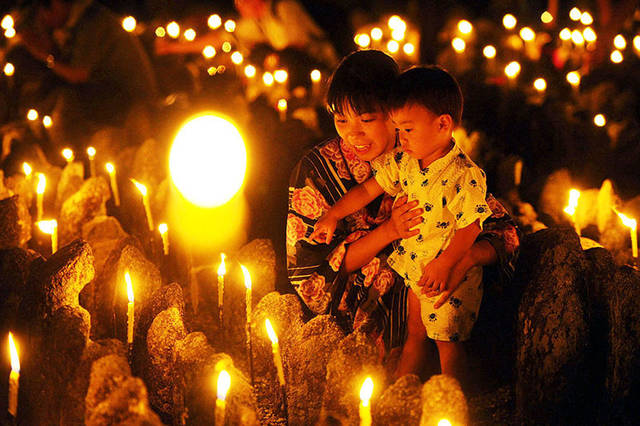その中でも、京都を代表する三大祭りの、祇園祭、葵祭、時代祭。
そして、3つの幻想的な火祭りの、鞍馬の火祭り、千灯供養、京都五山送り火をご紹介します!
町衆の粋を伝える「祇園祭」
一般には、17日(前祭・山鉾巡行と神幸祭)と24日(後祭・山鉾巡行と還幸祭)その宵山が広く知られ、他にも多彩な祭事がおこなわれる。
この祭は1000年の伝統を誇っており、再三中断、再興をかさねて京都の歴史とともに歩んできたものである。
祭りの象徴とも言える山鉾は町衆の手によって創意がこらされ、内容外観ともに豪華、絢爛なものとなる。
貴族の祭の「葵祭(賀茂祭)」
京都御所から下鴨神社・上賀茂神社へ新緑の都大路を、葵の葉で飾られた牛車や輿など、総勢500名以上の平安絵巻さながらの優雅な行列がねり歩く。
京都最古の祭で、1400年の歴史を誇り、王朝風俗を今に伝える。
明治から時代を遡る「時代祭」
葵祭や祇園祭に比べると歴史は浅いが、明治時代から江戸、安土桃山、室町、吉野、鎌倉、藤原、延暦と8つの時代を遡って続く約2000人の時代行列であり、歴史が目の前に蘇る鮮やかな祭り。
各時代の中心であった京都市でしかできない祭であり、京都市民が主体となり市民上げての祭りとなっている。
京都三大奇祭の一つ、松明を担ぐ「鞍馬の火祭り」
京都三大奇祭の一つの「鞍馬の火祭」は、動乱や不運が相次いだ平安時代中期940年に、御所に祀っていた由岐明神を北の鞍馬寺境内に遷宮し、北から平安を願ったことが起源となったと言われています。
「サイレヤ、サイリョウ」の勇ましい声と共に、鞍馬の里が燃え上がる松明の炎で埋め尽くされる、勇ましくも美しい火祭りです。
ロウソクが幻想的な「千灯供養」
明治中頃になって、周辺の墓石や石仏を1カ所に集めて、無縁仏を供養するようになったのが千灯供養のはじまりという。
念仏寺境内の西院の河原にまつられている、約8000体とも数えられる無縁仏にろうそくを灯し、手を合わせて供養する。
明治時代から続く宗教行事で、夏の嵯峨野の風物詩として広く知られている。
大文字送り火で有名な「五山送り火」
毎年8月16日、京都を囲む5つの山に「大文字」「妙法」「船形」「左大文字」「鳥居形」の順に点火されていきます。
「五山の送り火」は東山如意ヶ嶽の「大文字」がもっともよく知られ、ほかに松ヶ崎西山・東山の「妙・法」、西賀茂船山の「船形」、金閣寺付近大北山(大文字山)の「左大文字」及び嵯峨仙翁寺山(万灯籠山・曼荼羅山)の「鳥居形」の五つを指します。
宗教的行事でありますが、地元の人々によって始められ、受け継がれている行事です。
Among them, Gion Festival, Aoi Festival, Era Festival of the three major festivals that represent Kyoto.
And we will introduce the three fantastic fire festival, Kurama horse festival, Sen-no-lighting, Kyoto Gosan fire!
It is a festival held over the course of a month during the period from July 1 (Yoshinogi) to 31 (Nishikoshi Festival) of Yasaka Shrine every year.
In general, the Yaeyama is widely known on the 17th (pre-festival · Yamahoko cruise and Shinko festival) and on the 24th (late festival · Yamahoko cruising and returning festival), and a variety of other festivals are held.
This festival boasts a tradition of 1000 years and has been walking with the history of Kyoto as a result of repeated interruption and revival.
Yamaboko which can be said as a symbol of the festival is creatived by the hands of the townspeople, and its content appearance is luxurious and gorgeous.
<The "Aoi Festival (Kamo festival)" of the aristocratic festival>
Aoi Festival (Aoi Matsuri) is one of the three major Kyoto festivals, the most graceful and old-festival festival among our festivals.
From the Kyoto Imperial Palace to the Shimogamo Shrine / Kamigamo Shrine Elegant Matrix like New Year's Heiwa Shrine, boat cars and mikoshi decorated with Aoi's leaves, as well as a total of more than 500 Peaceful paintings.
It is the oldest festival in Kyoto, boasting a 1400 year history, telling the dynasty customs now.
<Dating back to the era from the Meiji Period>
The era festival (festival festival) was one of the three major festivals in Kyoto, celebrating the creation of Heian Shrine in Kyoto city.
Although it is shallow in history compared to the Aoi Festival and the Gion Festival, it is a period matrix of about 2000 people going back from the Meiji era to Edo, Azuchi Momoyama, Muromachi, Yoshino, Kamakura, Fujiwara, Era and Eight era, and history Brilliant festival that revives before.
It is a festival that can only be done in the city of Kyoto which was the center of each era, and it is a festival of citizen raising Kyoto citizen as the subject.
Kurama fire festival (Kurama no Hi Mamari) is one of the Yuki Shrine festival festival in Kurama, Kyoto City Sakyo Ward.
One "Kurama fire festival" of Kyoto Three Grand Dynasties festival is the transition from the North to the Kurama Temple in the north and Yuki Myojin, which was secretly dedicated to the Imperial Palace, in the middle of the Heian era when the disturbance and unfortunate succession went in the middle of the Heian period It is said that it was the origin.
It is a brave and beautiful fire festival filled with the brave voice of 'Sireaia, Saori' with the flames of torches where the village of Kurama burns up.
<Candle is a fantastic 'Senbon lighting'>
It is also the beginning of the Nanno Buddhist Temple that Kobo Daishi (Kukai) buried and mourned an unnamed remains that was left unattended.
In the middle of the Meiji Period, it is said that the beginning of the Senbon Lighting ceremony began to collect irrelevant statues by gathering the surrounding tombstones and stone Buddha in one place.
Light candles on irrelevant Buddhist monuments numbered in the West Buddha's river in Nembutsuji temple, which is counted as about 8000 bodies, and hand them together to sacrifice.
It is a religious event that has continued since the Meiji era and is widely known as a scenic feature of Sagano in the summer.
Kyoto Goyama Sentiment is one of the events representing the summer of Kyoto, in line with the Gion Festival. It is an Obon Festival that has the meaning of feeding a spirit of sending an ancestral spirit.
Every August 16th, five mountains surrounding Kyoto will be ignited in the order of "capital letter", "my legend" "ship form" "left capital letter" "torii shape".
"The capital letter" of Higashiyama Risozigakige is best known, and "Mikoto · Law" of Matsugasaki Nishiyama · Higashiyama, "Ship shape" of Nishiga Mineyama, Kinkakuji near Okitama Mountain (Capital letter) Left capital letter "and" Sugaruzenji Terayama (Mt. Mt. Kanayama / Mandala mountain) "of the torii shape".
It is a religious event, but it is an event that was started and handed down by locals.







